Samsung SSD XP941 Review: The PCIe Era Is Here
by Kristian Vättö on May 15, 2014 12:00 PM ESTRandom Read/Write Speed
The four corners of SSD performance are as follows: random read, random write, sequential read and sequential write speed. Random accesses are generally small in size, while sequential accesses tend to be larger and thus we have the four Iometer tests we use in all of our reviews.
Our first test writes 4KB in a completely random pattern over an 8GB space of the drive to simulate the sort of random access that you'd see on an OS drive (even this is more stressful than a normal desktop user would see). We perform three concurrent IOs and run the test for 3 minutes. The results reported are in average MB/s over the entire time.
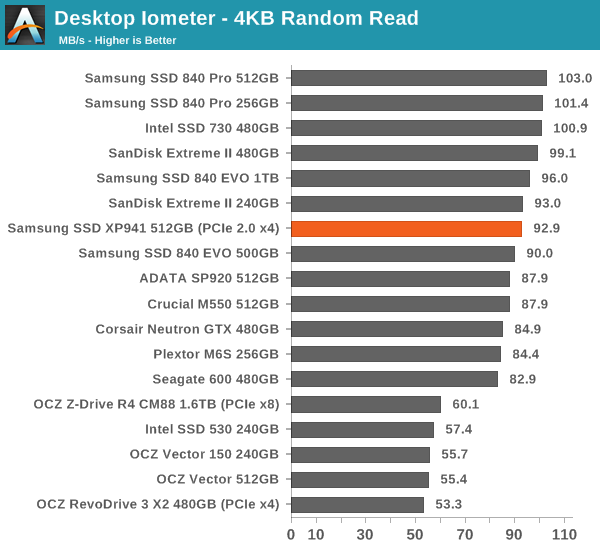
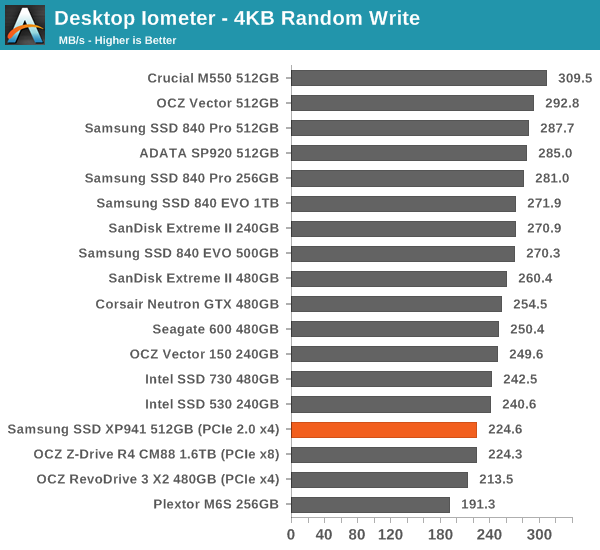
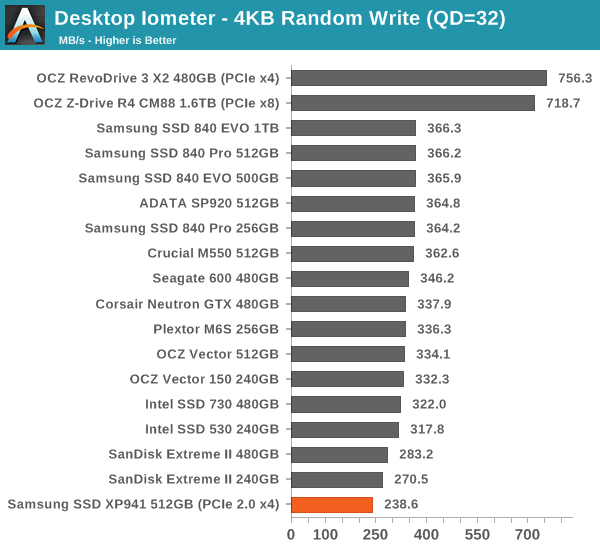
The random performance of XP941 doesn't stand out. Especially random write speeds are quite low by today's standards and queue depth scaling is close to non-existent. That said, I don't believe that high queue depth performance is really important for client workloads as our internal workload analysis shows that even under heavy use the average queue depth tends to be no more than 5. Our Storage Benches also show that even though the random performance isn't excellent, the strong sequential performance thanks to the faster PCIe interface makes up for the difference.
Sequential Read/Write Speed
To measure sequential performance we run a 1 minute long 128KB sequential test over the entire span of the drive at a queue depth of 1. The results reported are in average MB/s over the entire test length.
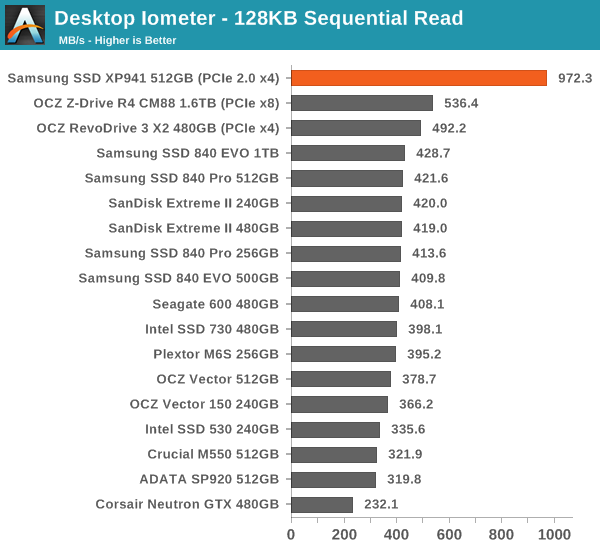
The sequential speeds are the highest we have ever tested in a consumer SSD. Even the 8-controller Z-Drive R4 behemoth can't beat the XP941, which really speaks for the efficiency of a single controller design. If you were to increase the queue depth, the Z-Drive would easily beat the XP941 since higher queue depth would increase parallelism and the Z-Drive could take advantage of all of its eight controllers. However, I was able to reach speeds of up to 1560MB/s with the XP941 at queue depth of 32, which is pretty much as fast as you can go with PCIe 2.0 x4 without tweaking any settings (the PCIe bus can be overclocked to achieve even higher speeds, though there can be a negative impact on random performance. We will investigate this at a later date).

AS-SSD Incompressible Sequential Read/Write Performance
The AS-SSD sequential benchmark uses incompressible data for all of its transfers. The result is a pretty big reduction in sequential write speed on SandForce based controllers. The XP941 does brilliantly in AS-SSD as well but now the strength of eight controllers starts to show for the Z-Drive. Even then, the XP941 is still about twice as fast as the fastest SATA 6Gbps SSD.
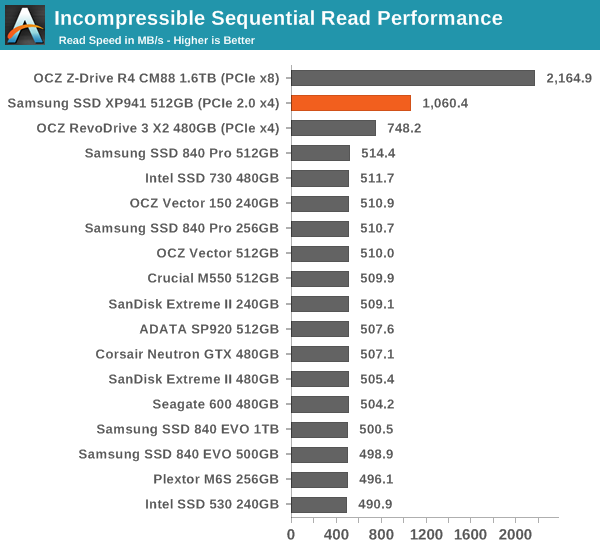
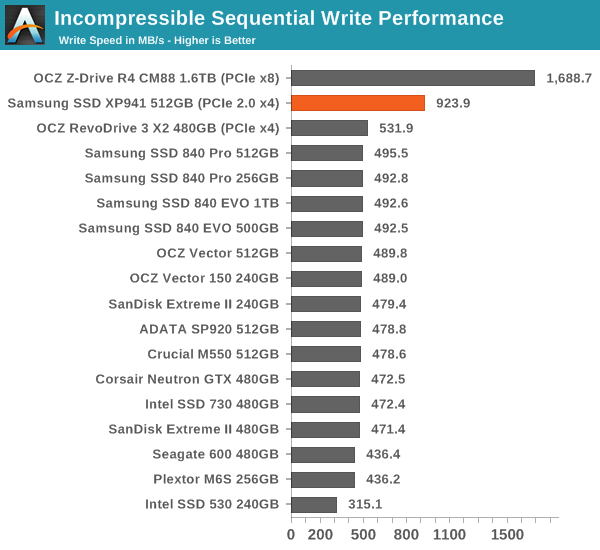










110 Comments
View All Comments
Ninhalem - Thursday, May 15, 2014 - link
I'm going to ask a slightly noob question: would it be possible to use these drives with the Z77 series if there was an update to the UEFI bios to recognize these drives in addition to Samsung providing the right drivers?wownotown - Thursday, May 15, 2014 - link
I have used a OCZ Revodrive for the last 2 years and love the performance over PCI-Express. Now that this is native with no bridge, it should be nice. Hopefully boot times improve with this tech. One the OCZ, you have a BIOS which adds 8 or more seconds to the boot time, which is nothing to complain about too much, but it would be nice to just boot into the OS, without the additional delays. I little pricey for me, but once competition enters the market, they will have to drop prices.landerf - Thursday, May 15, 2014 - link
Could you please alert Samsung to the fact consumers will want these in black PCB color. As soon as one starts doing it the others will follow.dstarr3 - Thursday, May 15, 2014 - link
I'll never understand why anyone gives a toss what the inside of their computer looks like.pipja - Thursday, May 15, 2014 - link
some people have naked setups...Jay77 - Thursday, May 15, 2014 - link
Doesn't one of the new Asrock Z97 boards have an M.2 connector that runs at pcie 3.0 x4? Stick that thing in there and see if boots!RamCity - Thursday, May 15, 2014 - link
On page two of this review, Kristian confirmed that the XP941 is bootable in the ASRock X97 Extreme6. They'll have a separate review of that motherboard in a review soon.RamCity - Thursday, May 15, 2014 - link
I mean ASRock Z97 Extreme 6!BMNify - Thursday, May 15, 2014 - link
MR city, do you happen to have any of those Everspin ST-MRAM DDR3 DIMMs has to hit equal density with consumer DIMMs aka these or their updates http://www.extremetech.com/computing/140318-eversp...id like you or anand (not while he's dunking biscuits in his tea OC :) to test them two/four sticks etc today and confirm they are far faster than NAND etc.... please
RamCity - Thursday, May 15, 2014 - link
Looks like interesting tech! Maybe there'll be a sneak preview at Computech in July.Rod